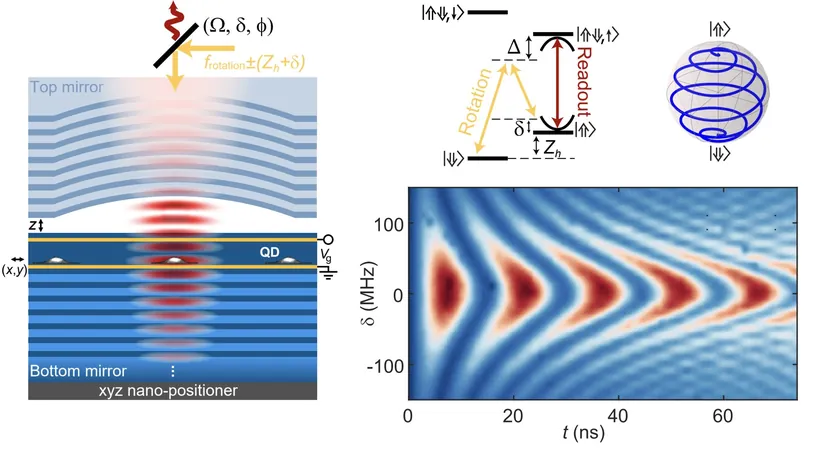
Revolutionary Breakthrough: Fast Control of Quantum Spins Paves the Way for Advanced Quantum Technologies
2025-08-27
Author: Wei Ling
Harnessing the Power of Quantum Mechanics
Quantum technologies are on the verge of revolutionizing various fields, surpassing classical systems by using quantum mechanical effects. At the heart of these innovations lies the spin—an intrinsic form of angular momentum carried by quantum particles that can efficiently store quantum information.
The Challenge of Connecting Spins and Photons
To establish reliable networks for sharing quantum information, spins must be effectively linked to photons, the fundamental particles of light. For decades, physicists have been on a quest to find methods to seamlessly interface spins with photons.
Quantum Dots: The Key Players
A promising solution involves quantum dots—tiny semiconductor structures that trap electrons or holes in specific energy levels. When integrated into finely-tuned optical resonators called microcavities, these dots can generate individual photons. Yet, keeping the spin's coherence intact amid disruptive magnetic noise from nearby nuclear spins has remained a significant hurdle.
A New Method to Suppress Magnetic Noise
Researchers from the University of Basel and Ruhr-Universität Bochum have recently unveiled an innovative approach to tackle this issue. Their groundbreaking study, published in Nature Physics, combines laser pulses with a process known as nuclear spin cooling to mitigate magnetic noise and enable rapid optical control over coherent hole spins within microcavities.
Mark R. Hogg and Richard J. Warburton, leading authors of this study, highlighted the effectiveness of their method, stating, "Quantum dots can serve as efficient sources of single photons. We've pioneered a technique using an 'open microcavity' that yields the highest efficiency currently attainable. While single photons are vital for quantum communication, entangled photons are even more valuable."
From Single Photons to Entangled States
To transform a single photon source into one capable of producing entangled photons, researchers can add an electron or hole to a quantum dot and utilize its spin. This process involves achieving entanglement between a spin and a photon, followed by manipulating the spin multiple times to ultimately generate spin-photon-photon entanglement.
Innovative Experimentation Pays Off
Despite facing skepticism regarding the compatibility of their spin control method with open microcavities, the researchers embarked on their experiment. They successfully trapped a solitary hole in a quantum dot using Coulomb blockade, locking in a charge state at each bias voltage. The next phase involved initializing the spin state using a technique from atomic physics known as optical pumping.
Revolutionary Raman Process Unveiled
For the spin transition, the team employed two lasers to create a Raman transition synchronized to the spin splitting frequency. Utilizing a technique called red detuning, the researchers ensured that the lasers didn’t directly excite the system but instead induced the Raman process. Much to their surprise, the setup worked seamlessly, allowing efficient spin manipulation.
Significant Reduction of Magnetic Noise
As the team rotated the spin on the Bloch sphere, they discovered that magnetic noise from nuclear spins diminished considerably. Their findings suggest that engineering the environment effectively reduces noise for hole spins, a notable advancement since previous strategies relied heavily on electron spins.
A Leap Forward for Quantum Computing
This significant achievement opens doors to creating high-fidelity cluster quantum states, facilitating new strategies for researchers focusing on the rapid optical control of hole spins. Hogg and Warburton expressed their enthusiasm to explore further, aiming to understand how the hole spin lessens nuclear noise and the potential limits of this method.
They intend to leverage their advancements—such as efficient photon collection, precise spin control, and enhanced spin coherence—to produce entangled photons and cluster states, a crucial step toward achieving practical applications in photonic quantum computing. This ambitious yet essential task underscores the complexity and potential of future quantum technologies.



 Brasil (PT)
Brasil (PT)
 Canada (EN)
Canada (EN)
 Chile (ES)
Chile (ES)
 Česko (CS)
Česko (CS)
 대한민국 (KO)
대한민국 (KO)
 España (ES)
España (ES)
 France (FR)
France (FR)
 Hong Kong (EN)
Hong Kong (EN)
 Italia (IT)
Italia (IT)
 日本 (JA)
日本 (JA)
 Magyarország (HU)
Magyarország (HU)
 Norge (NO)
Norge (NO)
 Polska (PL)
Polska (PL)
 Schweiz (DE)
Schweiz (DE)
 Singapore (EN)
Singapore (EN)
 Sverige (SV)
Sverige (SV)
 Suomi (FI)
Suomi (FI)
 Türkiye (TR)
Türkiye (TR)
 الإمارات العربية المتحدة (AR)
الإمارات العربية المتحدة (AR)